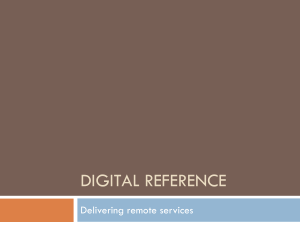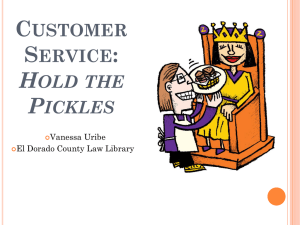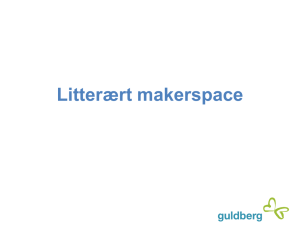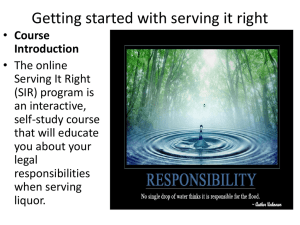Manage Quality Customer Service
advertisement
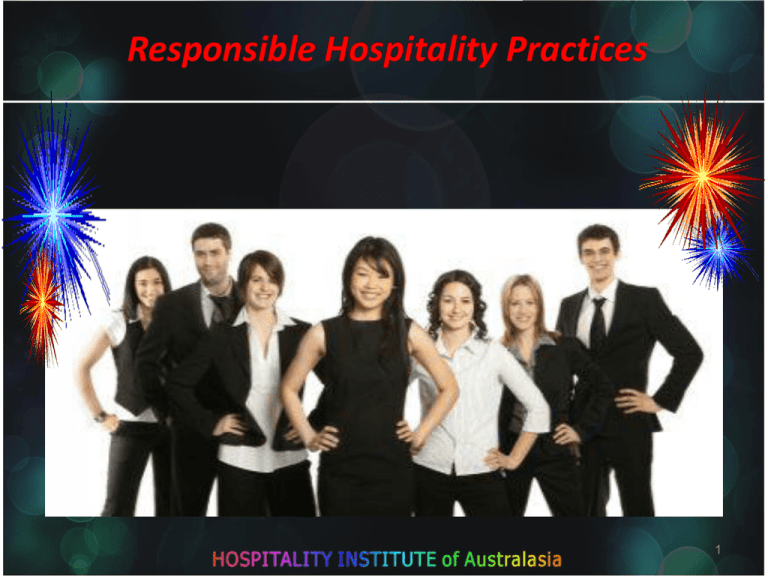
Responsible Hospitality Practices 1 Introduction Please work your way through the following learning pages. There will be a short assessment at the end of each section on this online course. You can open two windows on your computer – one for the lesson and a second for the assessment. If you are unsure of an answer you can refer back to the lesson to find the answer. You will have up to 4 attempts to get all the questions correct for each section. After 4 attempts the system will lock you out and you will have to contact our office between the hours of 9am and 4:30pm Monday to Friday. Please Note: You will have access to these learning sections for 3 months after completing your course. LOGIN using the Member LOGIN button and your username and password at www.hia.edu.au 3 Responsible Hospitality Practices Staff should be aware that the establishments trading methods may have a significant effect on surrounding businesses or nearby residents resulting from: noise (entertainment, motors, patrons) patron behaviour problems (e.g. yelling, swearing, abusing other people, vandalism). Responsible hospitality means providing a safe and enjoyable environment for patrons. It also means responsibly serving liquor to ensure that patrons do not become unduly intoxicated and subsequently a problem for management, staff and the neighbourhood. 3 Safe Environment Table and bar dancing should be considered high risk as well as conducting 'wet t-shirt competitions during which discounted liquor is served to patrons A safe environment may include: provide a range of free or cheap snack foods as drinking on an empty stomach will increase the likelihood of intoxication; train staff in the responsible service of alcohol; safe transport alternatives; drink size; availability of water; appropriate lighting inside and outside venue; adequate staff or security persons to monitor or control patrons behaviour, the convenient positioning of public telephones for patrons; displaying taxi cab and emergency telephone numbers; and adoption of RSA initiatives. 4 Responsible Hospitality Laws There have always been laws about the responsible service of alcohol in the Queensland liquor legislation. That is, rules about not selling to minors, unduly intoxicated or disorderly patrons. There were even rules about not selling liquor to sexual deviants or perverts (although no criteria were given to assess who fell into this category!) Early laws also touched on broader responsibilities such as requiring hoteliers to keep a lamp lit with at least two burners over the door from sunset to sunrise as a guide for travellers looking for accommodation and cracker style biscuits on the bar. Public expectations have continued to evolve over the years and now there is an increasing focus on the responsibilities of licensees in the way they conduct their business, Not only are licensees expected to follow the law and prohibit liquor to certain people such as minors, they are also required to promote responsible consumption and provide a safe environment for all patrons. In Queensland responsible hospitality laws were first placed in the legislation in June 1995. The majority of licensees within the industry conduct their businesses in a responsible fashion. However, a small number are interested in financial returns over the short term, with little concern for the consequences. This unfortunately has a flow on effect as other operators seek to compete for trade which gives rise to the adoption of irresponsible practices, The laws focus on promotions, games, competitions and activities that encourage the rapid and excessive consumption of liquor. This does cause harm and may lead to vandalism, public drunkenness and violent behaviour that affects the whole community. 5 Responsible Hospitality Laws There have always been laws about the responsible service of alcohol in the Queensland liquor legislation. That is, rules about not selling to minors, unduly intoxicated or disorderly patrons. There were even rules about not selling liquor to sexual deviants or perverts (although no criteria were given to assess who fell into this category!) Early laws also touched on broader responsibilities such as requiring hoteliers to keep a lamp lit with at least two burners over the door from sunset to sunrise as a guide for travellers looking for accommodation and cracker style biscuits on the bar. Public expectations have continued to evolve over the years and now there is an increasing focus on the responsibilities of licensees in the way they conduct their business, Not only are licensees expected to follow the law and prohibit liquor to certain people such as minors, they are also required to promote responsible consumption and provide a safe environment for all patrons. 6 Liquor regulations & other laws Other Laws Workplace health and safety legislation requires business owners to provide a safe environment for employees. Under health and food hygiene regulations licensees must ensure appropriate food handling and cleaning of public areas and conveniences. Fire safety laws require adequate fire fighting equipment, means of escape and fire evacuation plans. 7 Unacceptable practices An example of an unacceptable practice would be conducting a wet t-shirt competition with discounted drink promotions without adequate staff or security to monitor liquor consumption. Some patrons become unduly intoxicated and harass other patrons and staff. This incident has actually occurred: Free drinks were offered all night for women. Later in the evening a wet-shirt competition was held and later again a slave auction of young women was conducted The evening resulted in an alleged rape and a number of sexual assaults. 8 Unacceptable practices The Chief Executive for OLGR also has the power to close licensed premises and take action if there are any concerns with fire equipment, exits, health hazards or any other safety issues. The venue is to remain closed until all meters are rectified (s140). This will not only result in a considerable loss of trade, but also potentially tarnish a business reputation. Not only do licensees risk fines and closure, they also risk civil action if a patron is injured from a dangerous practice or unsafe drinking environment. Circumstances sometimes take care of Irresponsible practices as one licensee found out when providing flaming drinks at a bar that had a straw roof as part of an island hut theme. Not only was a large part of the venue destroyed by the fire, but also the irresponsible practices drew the attention of the insurance company. 9 Good practices Spotting Trouble If staff are pleasant and friendly when serving patrons, trouble will seem 'out of place'. Getting the right atmosphere is important — an attitude of 'anything goes' can encourage violence and loutish behaviour. Licensees have to earn respect from patrons A licensee who has earned the respect of patrons through fair treatment and a sociable, no nonsense manner will have fewer problems and the support of other customers in dealing with problems that do arise from time to time. Glass Removal Regular removal of glasses and empty bottles is important. It ensures that patrons are aware of staff and security, it reduces possible breakages and broken glass problems, and it also removes any potential weapons should trouble break out. 10 Good practices Get to know your regulars By getting to know your regular patrons by name, their usual drink, even perhaps the football team they barrack for, staff will encourage good behaviour through a friendly atmosphere and professional relationship Quiet corners Particular attention should be given to areas that cannot be easily seen by bar staff or security. Regular collection of glasses or table swabbing will let patrons know firmly that there is passive supervision. It will also act as a deterrent for troublemakers. 11 Over crowding Do not allow any area to become too congested with patrons. In crowded areas patrons trying to socialise will get pushed and shoved whilst standing and have difficulty moving and being served. The spilling and slopping of drinks and wandering hands can create tension, frustration and conflict. By regulating the number of patrons in an area you can: create a dimension of attractiveness through the impression of popularity and restricted access; ensure that liquor servers have enough time and visibility to assess levels of undue intoxication; comply with the responsible hospitality practice regulations; and comply with fire safety requirements. 12 Signage Exterior Signage OLGR Signage The licensed premises are required to display an exterior sign that includes the following details: Under the Act, licensees and permit tees must display the appropriate signage on the premises. These signs are available from the Office of Liquor and Gaming Regulation (OLGR) • the name of the premises; • the name of the Licensee; • the nature of the premises, and • the permitted hours for the sale of liquor. The exterior signage must be in a prominent location and in lettering at least 15 mm high. Under 18s are not permitted beyond this point 13 Definitions The following definitions apply to the Code of Practice 1. Practice - the manner in which liquor is served or supplied by licensees and permit tees. 2. Promotion - communication by licensees and permit tees trying to persuade and influence customers to consume liquor including: advertising - any form of advertisements or commercials through television, radio, Internet, mobile phone, newspapers, magazines, billboards, posters, catalogues, etc. publicity - generating commercially significant news in the mass media; personal selling - with one or more prospective purchasers for the purpose of making sales and includes providing free samples for tasting or consumption; and sales promotion - any other marketing activity that stimulates consumer purchasing such as. special offers - discounting, coupons, contests; and special methods - point-of-sale displays, other non-routine, non- personal efforts 3. Rapid - A male patron consumes 4 or more standard drinks in one hour. A Female patron consumes 3 or more standard drinks in one hour. 14 Acceptable Promotions Promotional activities have to be managed and planned as well as any other business activity. They have the potential to jeopardise the safety of patrons and also to disturb the peace and good order of the neighbourhood. Responsible hospitality laws under the Liquor Regulation 2002 require licensees to: 1. Engage in practices and promotions that encourage responsible consumption; and 2. Not engage in a practice or promotion that may encourage the rapid or excessive consumption of liquor. ACCEPTABLE practices and promotions: deterring the rapid or excessive consumption of liquor, for example by stopping patrons from taking part in skolling games; having non-alcoholic and low alcohol beverages available; serving patrons half measures of spirits on request. having drinking water available, free or at a reasonable cost; supplying liquor in standardised quantities that can be recognised by patrons such as serving spirits in nips, using glasses or jugs with measured quantities, supplying liquor in labelled prepackaged containers; and 15 Unacceptable promotional practices Activities and promotions which encourage rapid and excessive consumption such as: № Promoting or conducting sculling games; № Promoting drinks such as laybacks where a patron cannot monitor or control their consumption; № Consuming liquor from dispensers such as water pistols which do not allow a patron to monitor their consumption; № Producer/wholesalers or other persons supplying liquor on the condition that it is used to promote or conduct an activity which encourages rapid or excessive consumption or discourages patrons from monitoring or controlling their consumption of liquor; № Conducting free or discounted drink promotions without appropriate levels of staff or security to monitor consumption levels; 16 Unacceptable promotional practices • Supplying liquor in dispensers or containers that encourage rapid and excessive consumption or prevent patrons from monitoring/controlling their consumption; • Yard glasses for consumption; • Glasses which cannot be rested e.g. Test tubes; and • Providing liquor to a patron while holding their EFTPOS card or other property in a way that discourages the patron from monitoring or controlling their liquor spending. 17 Liquor Act 1992 s187 Abatement of nuisance or dangerous activity This section applies if an Investigator believes on reasonable grounds that: a) noise coming from licensed premises or a utility area for licensed premises is I. an unreasonable noise: or II. in contravention of an order under section 46; b) because of activity in or near the licensed premises, there is a danger to persons or property that is likely to be aggravated by the continued supply of liquor in the locality. Prescription of limits for noise that if exceeded constitute unreasonable noise For the definition unreasonable noise in section 187(5) of the Act, the limits for noise are as follows: a) between 6am and 10pm - the adjusted maximum sound pressure level LA10, plus adjustments for tonal and impulse components, exceeding the background level LA90 by more than 10dB(A); and b) between 10pm and 6am - the sound pressure level LOCT10, in a full octave band with centre frequencies from 63HZ to 2000HZ, exceeding the background level LOCT90 by more than 84:113 in any octave band. 18 Noise Nuisance Licensees should ensure that both management and staff are aware of any noise conditions on a license. At 3 am when a noise nuisance is being caused, and the licensee has gone home for the night, staff must know: where the license document is located; the specific noise conditions on the license document; whether a noise limiting device has been installed on music equipment and how to ensure it is not intentionally de-activated; the powers of investigators and police to demand the noise be reduced; and the powers of investigators and police to close the venue. 19 How can I tell if the venue is a noise nuisance? The simplest method to determine if the noise is too loud is to walk to the property line of the closest residence to the venue whilst entertainment is being conducted. It is important to remember that when staff are working in the venue it is difficult to imagine how loud the noise might be for neighbours, Can you make out the words to the song? Can you hear the bass? Are patrons singing or talking loudly on entry or departure from the venue? Could windows or doors be shut to contain the noise more effectively? If the answer is YES to any of these questions then the entertainment is definitely too loud. Staff should advise the supervisor or manager so that the level of volume can be reduced. If security are on duty they might be able to assist in encouraging patrons to move on when leaving etc. 20 What are licensees responsible for? The Licensees are responsible for the noise emanating from: Entertainment at the venue Patrons at the venue Patrons entering or leaving the premises Other safety management issues In providing a safe environment, the list of safety measures that may be considered is quite extensive. Other issues that licensees should consider include: Regular fire and emergency evacuation training for staff; Ensuring emergency equipment is in good order and regularly inspected; Ensuring patrons leave after closing and do not gather outside; Alerting taxis prior to closing to be available for patrons, particularly on busy nights; Displaying posters and signs to remind staff and patrons of the issues and disciplinary actions involving undue intoxication and underage drinking; Displaying trading hours in a prominent position; Ensuring that furniture and fittings are in good repair and do not contribute to accidents; and Being aware of the potential weapons some patrons may possess. 21 You are ready for assessment ? You have now completed the reading Section of this online course and you are now about to begin the assessment questions. You will be given four attempts to correctly answer the questions. You must get all questions correct in a single attempt to pass each section. If you do not pass after 4 attempts you will be locked out of the online course and you will need to call our support line on 1300 783 757 When you have successfully completed a section please click the "Finish" button to return to the main menu and complete the remaining sections. 22 Assessment Question 1 Choose two acceptable practices for providing and maintaining a safe environment in and around the licensed premises from the list below. helping patrons departing the premises by allowing staff to make phone calls for patrons to arrange transport, or arranging access to telephones for patrons providing appropriate lighting inside and outside the venue inadequate staff or security to monitor liquor consumption wet t-shirt competition with discounted drink promotions For further information please turn to slide : 10-11 23 Assessment Question 2 Choose two unacceptable practices for providing and maintaining a safe environment in and around the licensed premises from the list below. wet t-shirt competition with discounted drink promotions serve flaming drinks when ceiling is made of straw providing appropriate lighting inside and outside the venue arrange taxi for patron For further information please turn to slide : 8-9 24 Assessment Question 3 A slave auction of young women encourages harassment of patrons and/or staff? Choose either True or False. True False For further information please turn to slide : 8 25 Assessment Question 4 Licensees are responsible for which type of noise coming from their venue? Choose three correct answers from the list below. entertainment at the venue neighborhood parties patrons entering or leaving the premises motors such as air conditioning units and generators used for their business Hint for further information refer to slide : 21 26 Assessment Question 5 Choose two unacceptable practices and promotions that may encourage rapid or excessive consumption of liquor from the list below. serving patrons half measures of spirits on request supplying liquor in standardised quantities that can be recognised by patrons promoting or conducting skolling games supplying liquor in dispensers or containers that encourage rapid and excessive consumption, or prevent patrons from monitoring/controlling their consumption having non-alcoholic and low alcohol beverages available Hint for further information refer to slide : 16-17 27 Assessment Question 6 Choose two acceptable practices and promotions that encourage responsible consumption of alcohol from the list below. promoting or conducting skolling games yard glasses for consumption having non-alcoholic and low alcohol beverages available deterring the rapid or excessive consumption of liquor glasses which cannot be rested e.g. test tubes Hint for further information refer to slide : 15 28
